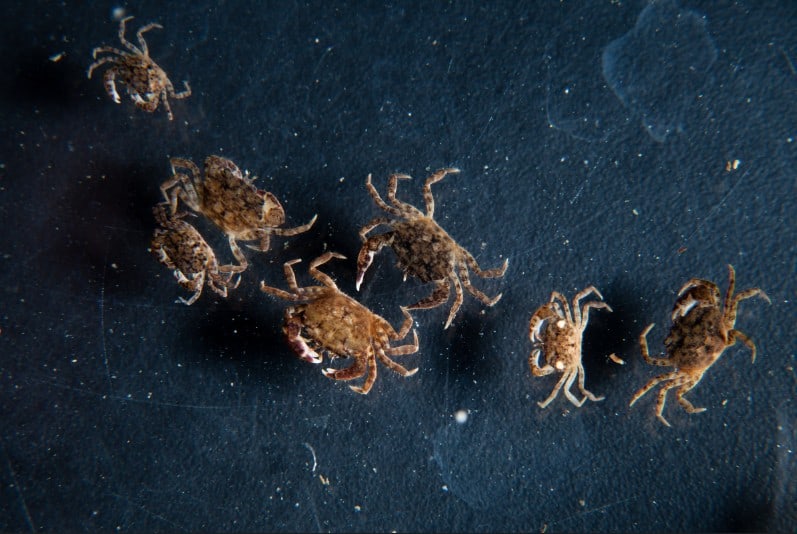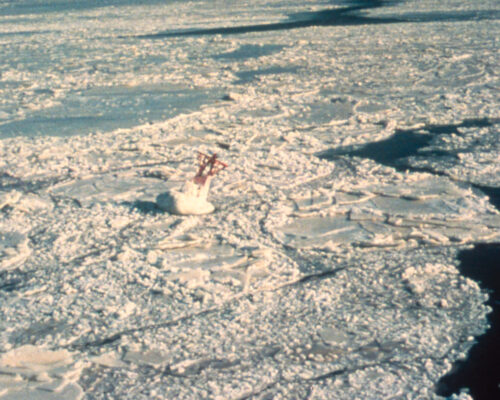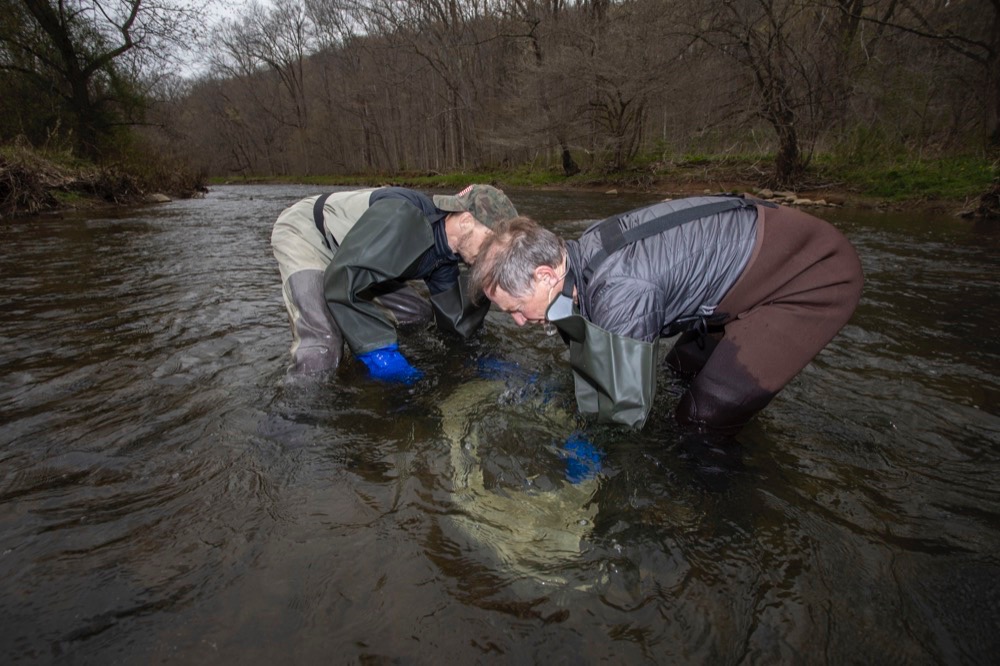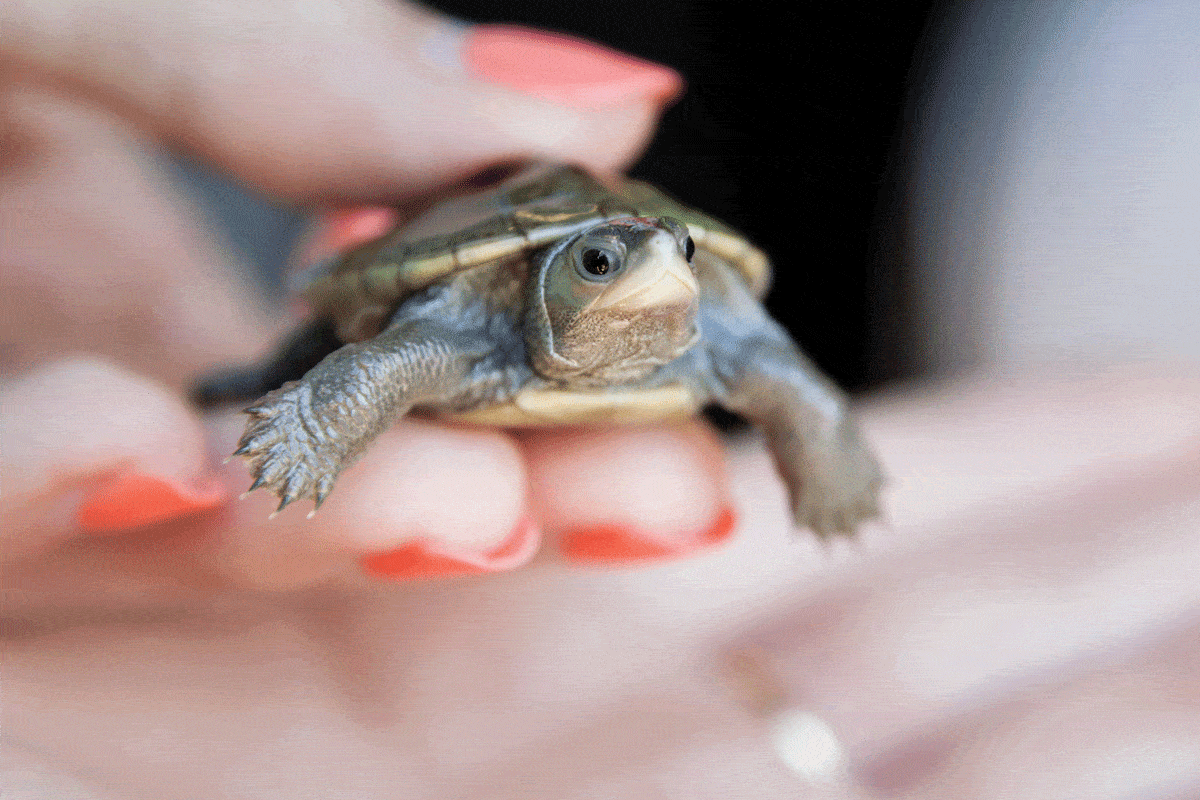Battling brain-eating invaders. For science!
by Jeff Holland
It’s right out of a 1950s Hollywood horror film: An evil alien, loxo, invades the bodies of unsuspecting victims, takes control of their minds, and implants their bodies with its larvae. The victims, unable to resist, turn into zombies whose insides throb with alien spawn. Before loxo can take over the world, scientists come to the rescue.
Wild as it seems, this is really happening right here on the Chesapeake Bay. The zombified victims in this case are tiny mud crabs and the evil invader is a parasitic barnacle from the Gulf Coast called loxothylacus panopaei—known to researchers as “loxo.”
Mud crabs, of course, are not the blue ones that turn red in the steam pot and wind up on top of your picnic table covered with Old Bay. Mud crabs are bitty critters the size of your thumbnail. They’re one of the many species that consider oyster reefs the perfect habitat, along with small fish, shrimp, and eels. We have two kinds of mud crabs here on the Chesapeake: those with black fingertips, and those whose tips are white. Both have been infected with the parasite at a rate as high as 50 percent.
The science heroes in this story are mainly connected with the Smithsonian Environmental Research Center (SERC). Located on the Rhode River, SERC’s 2,650-acre campus encompasses forests, wetlands, marshes, and 15 miles of protected shoreline that the staff use as a natural laboratory for long-term and cutting-edge ecological research on the issues impacting the confluence of land and water. Many of SERC’s studies on water quality, land use, and global warming have been going on since the center’s founding in 1965.
SERC researchers have been studying the prevalence of loxo in populations of the white-fingered mud crab since the 1990s. The current Mud Crab Team comprises 15 dock owners and collaborators, 19 staff and interns, and, up until this year when the coronavirus pandemic struck, 156 volunteers. It’s led by Monaca Noble, a biologist at SERC’s Marine Invasions Laboratory. Over the past decade, Dr. Noble has studied invasive organisms hitch-hiking across oceans in the ballast tanks of commercial freighters as well as the ones that infect the mud crabs here on the Bay.
Noble explained the situation in a 2015 article she published on Discovermagazine.com. “Loxo females inject themselves into the shell of recently molted crabs and take control of major functions like molting and reproduction,” she wrote. “Loxo’s control over the crab is so complete that the crab essentially becomes a zombie working to raise the parasite’s young before dying an untimely death.” It affects both male and female crabs, sterilizing them and changing the behavior and even the physical structure of the males to force them to care for the parasitic eggs. One study found it makes them up to twice as fast; more 28 Days Later than Night of the Living Dead.
The research project’s success depends on a corps of citizen-scientist volunteers who collect mud crabs from sites located all around Maryland’s portion of the Chesapeake. Volunteers set habitat collectors, which are small plastic crates filled with dead oyster shells. There might as well be a little “VACANCY” sign flashing to attract mud crabs looking for a new home. After the habitats have been on the bottom for two months, researchers gather and bring them to the laboratory, measuring the resident crabs, determining their sex, and checking for outward signs of the loxo parasite.
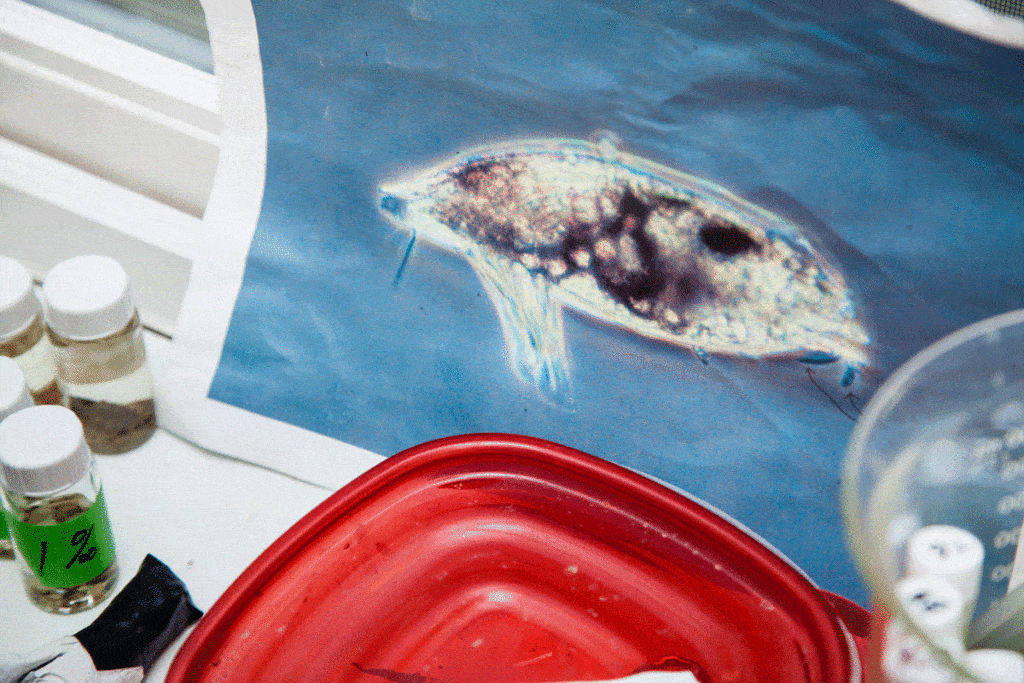
“We haven’t found many parasitized crabs this year, since the parasite doesn’t do too well in low salinity,” Noble explained in a recent phone interview with CBM. “There are more down at Oxford and Solomons,” where the Bay water is saltier.
The current viral pandemic has curtailed the participation of citizen-scientists. Without those volunteers, only a subset of the planned sampling will be completed. But they’ve come up with another solution: tapping into local schools.
“I still have two interns who are doing remote internships,” she said. “We’re working on a new citizen-science program that will be more high-school oriented.” The two interns are from nearby South River High School. They’re doing their lab work at home, taking measurements and pictures to capture data on the crab under the supervision of two of their teachers. “Since we can’t have volunteers in the lab like we used to, we are investigating whether or not we can get accurate crab measurements using photographs,” she said.
Noble and her staff interact with teachers and interns through an online platform called “Zooniverse” that allows volunteers from around the world to contribute data to research. “The Zooniverse platform has some good measurement tools that we are testing,” she said. “If we can indeed get good measurements with the photos, we can have high-school students measure the crabs for us.” The high-school teachers have been working to develop the project and writing curriculum to use in their classrooms (or virtual classrooms, as will likely be the case for this coming school year).
“I’m excited about the educational component we’re developing,” Noble said. “We’re going to engage more high-school classes so the students there can collect and analyze the data. It gives us the data we need, but it gives them the experience of gathering the data and it can be done 100 percent remotely.”
Part of the researchers’ goal is to figure out why the infection rate varies from sample to sample, assessing salinity and temperature at the sites and whether mud crab populations themselves vary depending on the parasite. Mud crabs may go largely unnoticed and unsung, but their presence contributes to healthy oyster reefs and ecosystems, and their loss would reverberate.
There’s another reason for concern, according to SERC. A similar parasite in the Gulf of Mexico does affect blue crabs, and if it managed to make its way to the Bay, it could wipe out the crabbing industry here. Now that’s a scary thought.

